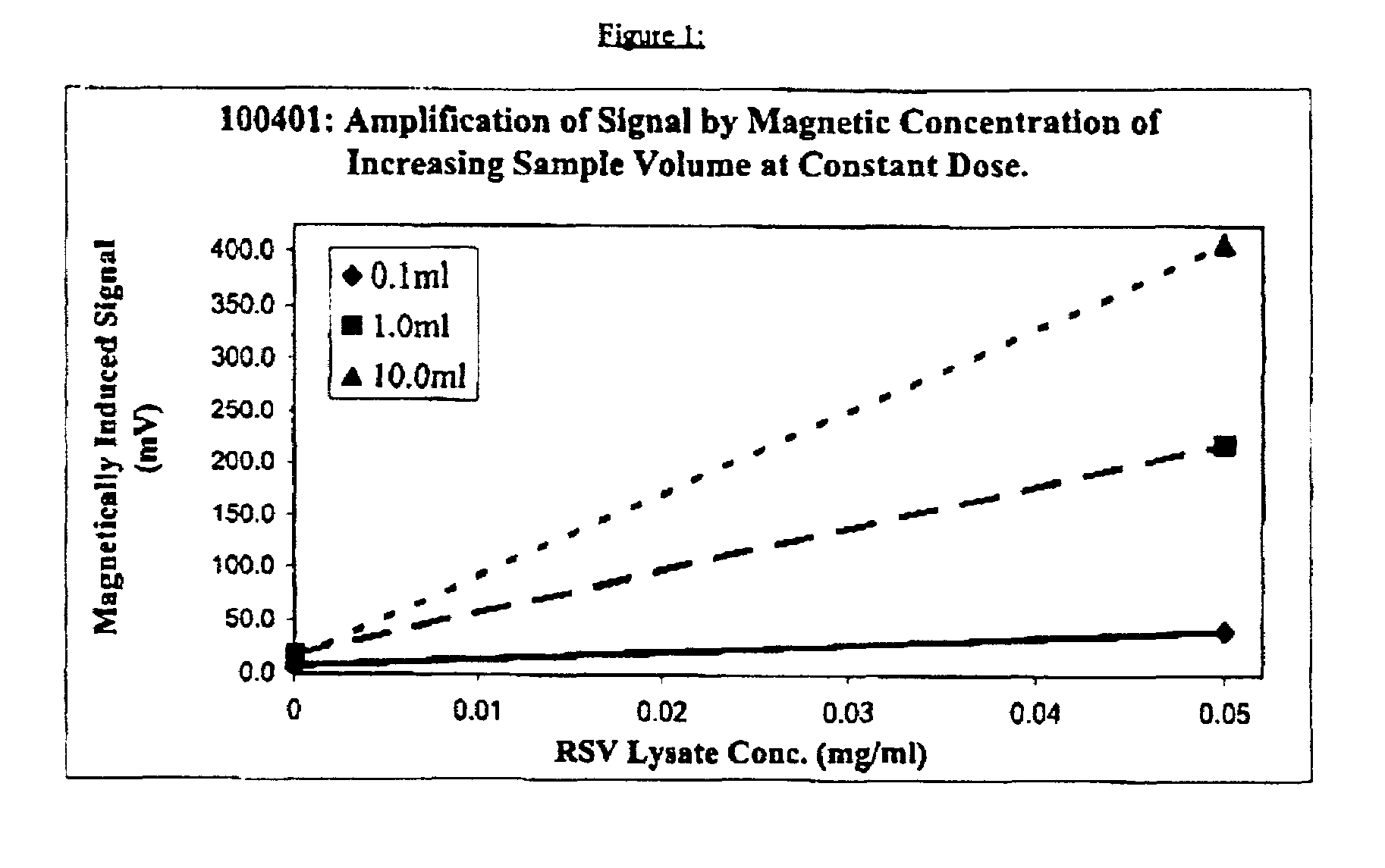Process for (A) separating biological/ligands from dilute solutions and (B) conducting an immunochromatographic assay thereof employing superparamagnetic particles throughtout
a technology of superparamagnetic particles and immunochromatographic assays, which is applied in the direction of biomass after-treatment, instruments, analysis using chemical indicators, etc., can solve the problems of inability to identify or quantify the small amount of biological ligand obtained by concentration, and the need to remove the superparamagnetic particles used in ligand concentration and subject the concentrated ligand to an identification or quantification assay
- Summary
- Abstract
- Description
- Claims
- Application Information
AI Technical Summary
Benefits of technology
Problems solved by technology
Method used
Image
Examples
example 1
[0016]A partially purified viral lysate of respiratory syncytial virus (“RSV”) obtained from Chemicon (Catalog #Ag857, Lot 21031072) was diluted in an aqueous buffer of pH 7.8+0.1 having the following composition:[0017]Tris base—24.22 grams per liter (g.p.l.)[0018]Triton X-100—10 ml. / liter[0019]T ween 20—10 ml. / liter[0020]N-tetradecyl-N, N-dimethyl-3-ammonio-1-propane sulfonate—20.0 g.p.l.[0021]Sodium azide—0.2 g.p.l.[0022]Water added to make 1 liter
The resulting dilution contained 0.05 mg / ml. of RSV lysate. Samples of 0.1 ml., 1 ml. and 10 ml., respectively of this dilution were carefully withdrawn after thorough mixing. To each of the 3 samples there was then added 5 microliters of approximately 250 nm average mean diameter superparamagnetic particles consisting of ferrofluid subunits of 1–30 nm diameter embedded in and each separately surrounded by BSA, which composite particles had been previously coated with anti-RSV monoclonal antibody obtained from Viro Stat, Inc. (Catalog #0...
example 2
[0030]This example involves a possible use of the superparamagnetic particles described herein in an experimental ICT test for quantifying Legionella pneumophila serogroup 1 in environmental water. The present commercially available test is described in copending, commonly assigned U.S. application Ser. No. 09 / 458,998 filed Dec. 10, 1999 as a continuation-in-part of copending, commonly assigned U.S. application Ser. No. 09 / 139,770 filed Aug. 25, 1998.
[0031]In this experiment, two 100 ml. samples of cooling tower water were drawn at Hood Dairy, Portland, Me. and held at temperature of 2–8° C. To one of these samples was added sufficient Legionella pneumophila serogroup 1 bacteria to enrich the sample bacteria content by 95 colony-forming units (“CFU”) per ml. Both samples were subjected to a filtration concentration on a small pore membrane as described in detail in copending U.S. application Ser. No. 09 / 458,998. The particulate retained on the membrane was recovered on a swab in eac...
PUM
| Property | Measurement | Unit |
|---|---|---|
| average mean diameter | aaaaa | aaaaa |
| average mean diameter | aaaaa | aaaaa |
| diameter | aaaaa | aaaaa |
Abstract
Description
Claims
Application Information
 Login to View More
Login to View More - R&D
- Intellectual Property
- Life Sciences
- Materials
- Tech Scout
- Unparalleled Data Quality
- Higher Quality Content
- 60% Fewer Hallucinations
Browse by: Latest US Patents, China's latest patents, Technical Efficacy Thesaurus, Application Domain, Technology Topic, Popular Technical Reports.
© 2025 PatSnap. All rights reserved.Legal|Privacy policy|Modern Slavery Act Transparency Statement|Sitemap|About US| Contact US: help@patsnap.com

